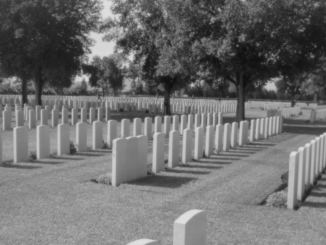More writings by uncle, John Alldridge. This time he is reporting from South America in 1960 for the Birmingham Evening Mail – Jerry F
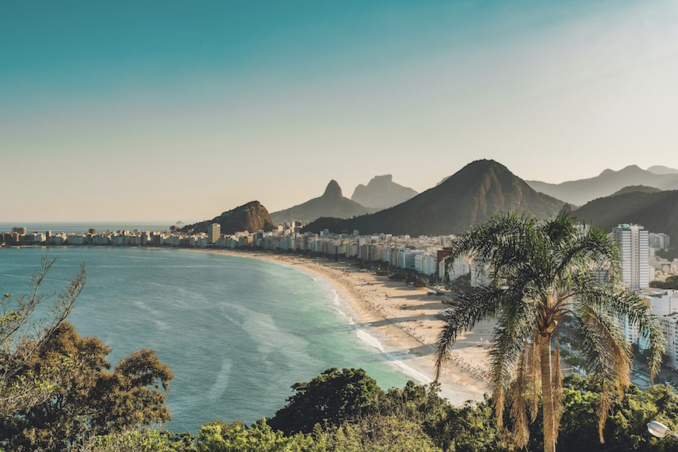
Copacabana Beach, Rio de Janeiro,
bisonlux – Licence CC BY-SA 2.0
I am writing this at a window seven floors up above the fabulous crescent of sand and surf they call Copacabana Beach.
A fine tissue of mist still hangs over the sea, screening the islands and the towering white hotels. But soon the hot Brazilian sun will burn it away; and to a crashing crescendo of surf the curtain will go up on the most fantastic transformation scene in the world.
This four miles of silver sand, fringed by a boardwalk of snaking black-and-white mosaic, is Rio’s backyard, its safety valve, its Hyde Park or Monkey Parade.
Here they come, the Cariocas of Rio, to lie near-naked in the sun, to let off steam, to play endless games of volleyball, to do anything but swim.
It is considered very bad form to get drowned in the crashing breakers directly in front of your hotel. Statuesque lifeguards stand all day long on imposing look-out posts to prevent mutual embarrassment.
There is no beach quite like it anywhere in the world. You can look along the whole length of it and never see a deckchair, an ice cream stall; not a single broken bottle or cigarette packet.
Because it is always summer on the beach it explains a good many of the things I have seen so far in Brazil …
You no longer have to go “Rolling down to Rio.” A Pan-American jet-clipper will fly you there in less than half a day.
You take off from New York around ten o’clock, enjoy a long, leisurely lunch of green turtle soup, Kennebec salmon in aspic, washed down with a Chateau Pagie ’57, and very soon it is teatime in Trinidad.
You step out of a cool, air-conditioned cabin and sit and sweat for forty minutes in a musty airport lounge that smells of damp bathing costumes. Outside the thunder clouds pack in over densely wooded hills and you expect to hear voodoo drums any minute.
You doze for a while in your armchair, and when you look out of your window again you are flying over what from that height looks like a vast field of brussels sprouts with a muddy ditch winding and twisting through it.
The ditch is the Amazon, finding its tortuous way 3,900 miles to the sea. The field is the Matto Grosso — the jungle.
For hundreds of miles it rolls under you, unchanging. And for hour after hour you see no house, no human habitation, no road, no smallest patch of cultivation, no human being, no break in the relentless monotony. Only the river. And the jungle …
Somehow it seemed indecent to be nibbling canapes and sipping highballs while that green hell slipped away below.
But watching it you learn the first lesson about South America and Brazil in particular. It is a constant battle with nature; to tame and harness it. It is a battle that is only just beginning.
Brazil — or to give it its proper title, the United States of Brazil — is the fourth largest country in the world. It is larger than the United States, larger than Australia. And a third of it is jungle.
But for the jungle Brazil could hold 900 million people instead of a mere 60 millions. Because of the jungle it takes a train nine hours to cover the 250 miles between Rio and Sao Paulo.
The jungle never gives up. It seeps into the suburbs and creeps into the gardens. Yesterday, just before dusk, I took a cable car up the Hunchback Mountain or Corcovado, where the giant concrete Christ stands, arms spread in eternal forgiveness, over the city.
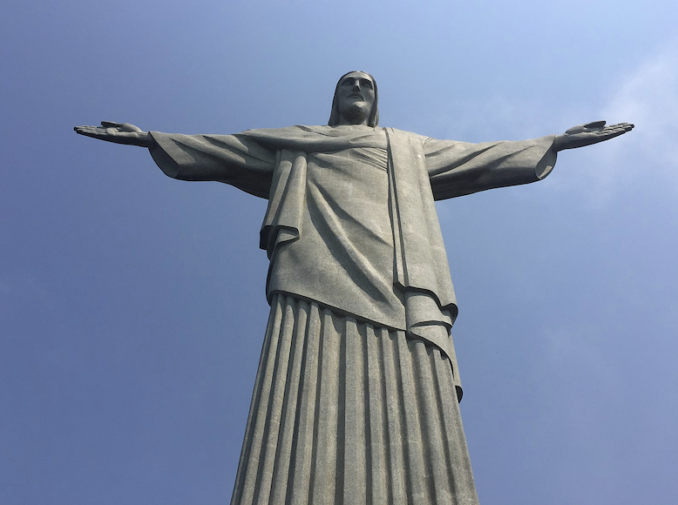
Upward looking image of Christ the Redeemer,
PLBechly – Licence CC BY-SA 4.0
Within ten minutes we had climbed into the jungle, among the fireflies and the bats and the chirping cicadas.
Coming down again in the twilight, in that dramatic split second before Rio turns on its million lights, it seemed we were hanging down over a dead city, lying helpless before the implacable jungle; which would throttle and choke those gleaming white skyscrapers just as it has already half-strangled the once-proud rubber capital of Manaus.
City of millionaires and modern buccaneers
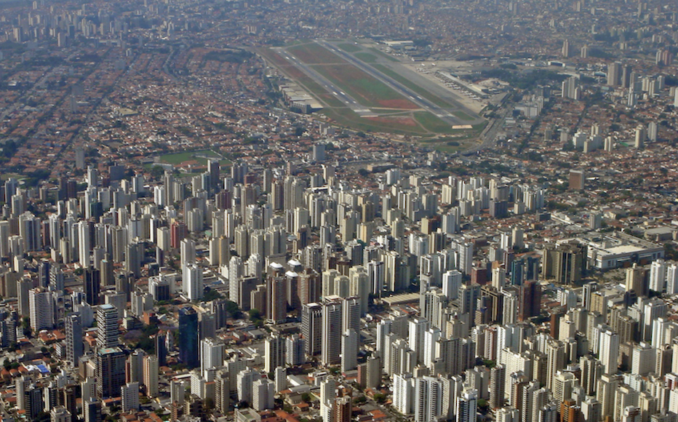
São Paulo city and Congonhas airport,
Mariordo – Licence CC BY-SA 3.0
Sao Paulo is the Chicago of South America. It is a big, breezy, roaring city; studded with so many skyscrapers that from the air it looks like a petrified forest; and bursting with prosperity right down the seams.
It is the fastest-growing city in South America. (They told me this the moment I stepped off the plane and I never stopped hearing it).
According to the proud statistics, they build a new house here every hour. It is expanding in all directions at once, and nobody knows where it will stop. Or cares.
In 1890 the population was a paltry 60,000. By 1920 it had reached its first half-million. By 1927 it was 1,700,000 and catching up fast on Rio. By 1950, with 2,841,940 Paulista all told, it had caught up and passed Rio. And today it must be touching the three million mark.
Its industrial growth has been equally fantastic. The State of Sao Paulo earns half the total revenue of Brazil, and pays half the taxes.
It produces more than half the country’s coffee (and that is about a quarter of all the coffee in the world). It turns out 60 per cent of Brazil’s textiles and chemicals, and 80 per cent of its electricity materials, rubber goods, and machinery.
A more-than-healthy rivalry exists between Sao Paulo and Rio, which resemble each other about as much as Belfast resembles Dublin.
Sao Paulo says it is the lonely locomotive pulling the other 19 Brazilian states. Rio replies acidly that every Paulista has only one ambition in life—to die in Rio …
Three reasons probably explain the extraordinary vitality of this bustling bully of a city. There is the climate, for one thing. It lies on a windy plateau 2,000ft. up. In the mornings it is often a misty city.
At this time of year it rarely warms up much before mid-day. By then the tempo of the city has got into its stride. While the rest of Brazil is yawning in siesta, Sao Paulo is up and doing and on the make.
Then it has the cheapest supply of electric power in South America. And for that it can thank the British and Canadian engineers who, years ago, began the two gigantic dams which generate a million horse-power between them.
Like a lusty, greedy child that cannot have enough of anything, Sao Paulo squanders 202,000,000 k.w.h. a month and grumbles at the frequent power cuts.
But the most dramatic reason is simply that Sao Paulo is not really a South American city at all. It owes much more to Europe and North America.
You have to scratch hard to find a Paulista who can claim both parents of Brazilian stock. I drove round town in a taxi owned — and very competently driven — by a young Japanese. I had my hair cut by an elderly Frenchman. My waiter at lunch had a German father and a Portuguese mother.
I ordered pizza cooked by a chef who was born in Naples. And I went with an English girl to see a monument that commemorates her Brazilian uncles who were killed during Sao Paulo’s abortive and bloody War of Secession back in the thirties.
If I had had more time I could have taken an aperitif on the pavement outside a French bar; dined in a Russian restaurant, and danced to a Viennese orchestra; or spent the evening in some dimly lit American-style nightclub where the waiter discreetly shines a torch on your bill — presumably to spare you the embarrassment.
Such a virile mixture of racial temperaments has given Sao Paulo the same rugged individualism you find in Chicago. It is an asphalt jungle where the results square all accounts and no holds are barred.
This is no new thing. The first Paulistas were adventurers who followed the Portuguese flag up jungle paths in search of gold and those precious stones — emeralds, diamonds, amethysts, tourmalines, rubies, beryls, sapphires — that flash fire from the showcases in my hotel lobby.
Half pioneer, half pirate, they called themselves bandeirantes; and are honoured in Brazilian history books about on a par with our own Francis Drake and Captain Kidd.
The strain persists: though the buccaneers today drive gold-plated Cadillacs.
Nobody has ever counted them; but they tell me there are at least 500 dollar millionaires in Sao Paulo today: with another thousand on the way up.
They are colourful characters, by and large; with a robust appetite for life.
A rags to riches story run raving mad
The best-known of Sao Paulo’s dollar millionaires is probably Francisco “Baby” Pignatari.
When he’s at home — which is not very often — he lives in a villa the size of the Dorchester, complete with two Turkish baths, a shooting gallery, a miniature sports arena, and a swimming bath which has an artificial waterfall at one end and a cocktail bar at the other.
But, by Paulista standards, the 40-year-old “baby” is just a playboy, a johnny-come-lately.
The richest and most powerful of all these Paulista dollar barons calls himself Count Francisco Matazarro but is better known to Brazil as Chicinho. He is a sour, sad-faced tycoon who owns more money and wields more power than Haroun-al-Raschid.
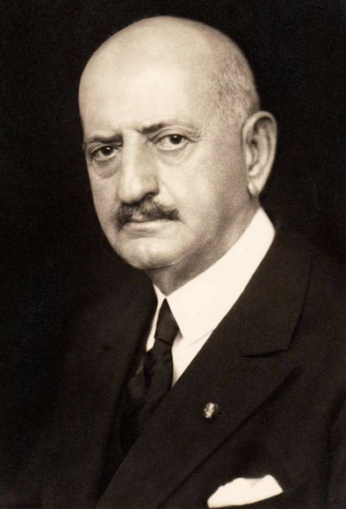
Count Francisco Matazarro,
Francisco Matarazzo Museum – Public domain
You can’t go into a kitchen in Brazil without finding a bottle or a packet or a tin marked with the magic name “Matarazzo”.
He is Industrias Reunidas Matarazzo. He is I.R.M. Which means he is textiles, sugar, flour, jam, fats, spaghetti, salt, olive oil, paper, alcohol, candles. He is, in fact, the source of life whereby Brazilians live.
He employs a labour force of a quarter of a million men and women. And draws the largest personal income in the world – 50,000 dollars a day.
How the Matarazzo fortune came about is the rags-to-riches story gone raving mad.
Chicinho’s father came over from Italy in the 1880s and sold bananas in the streets of Sao Paulo. Business prospered and he went into sausages and started a factory from scratch. From sausages he moved into flour He needed sacks for his flour, so he bought up a few jute plantations and made the sacks for himself.
Later he branched out into soap and chemicals and, to keep the costs down, packed them in boxes and bottles from his own factories.
When transport became a problem he built his own fleet of trucks and ships.
And to be sure that he always had money handy he founded his own bank.
In 1937 the old man died and Chicinho took over where father left off. He, too, has the Midas touch. A ranch he bought just for quiet weekends now raises pedigree cattle and employs 15,000 hands.
Like most tycoons, he had prickings of conscience late in life. He has made generous gifts to Sao Paulo art galleries and museums. But for all his Tintorettos and Van Goghs, Chicinho looks a most unhappy man.
His greatest rival is an equally uninhibited character. But he does at least enjoy being rich. Unlike Chicinho, Assis Chateaubriand is a free-spending, lively type in the best Paulista tradition.
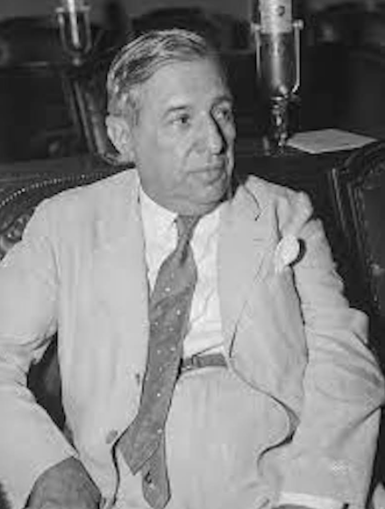
Senador Francisco de Assis Chateaubriand ,
Unknown – Public domain
No one seems to know where his money comes from — or if he ever had any to start with. But he owns twenty-eight newspapers, half a dozen magazines, 19 radio programmes, and a couple of TV stations.
He is the most powerful man in Brazil, because as its most influential publisher he keeps a dossier of scandalous gossip on every prominent man in the country. Some of it is mere rumour; but it is devastatingly effective. There is no law of libel in Brazil; or, if there is, no one bothers to bring an action against an outspoken Press which uses “murderer” and “thief” almost as terms of endearment.
But Assis enjoys life. He is mad on aviation and has founded flying clubs all over the country. He is also passionately pro-British. When “commuting” to Europe — which he does about once a month — he insists on flying in a British plane.
His proudest moment came when he was appointed Brazil’s ambassador to the Court of St. James. (He promised to open a nightclub in the Embassy and import a real Samba band, but was unfortunately talked out of it.)
In honour of Churchill’s 80th birthday and Princess Margaret’s wedding, Chateaubriand’s most important papers ran special front pages in red, white, and blue.
It is well to remember this affection which older Paulistas hold for the British. It tends to be played down by the newer generation. But men like Assis — and much humbler Paulistas like the porter at my hotel — remember that it was the British who gave them their light and power; who brought out from England their first trams; and laid that fantastic railway line which tunnels and winds its way down 3,000ft to the sea at Santos.
I think we could do much more than we are doing to sell the new Britain to Brazil.
– We could, for instance, bring a strong British light car out to Sao Paulo to compete with the Volkswagen and the jeep, which are now being made here in thousands in Brazilian factories.
– We could send out the sort of salesman who is not afraid to get tough and punch a hole through the formidable tariff wall; and then get away from the lush hotels and go up-country “bushwhacking” for trade, as the Germans and the Italians and the Japanese are doing.
– A cheap-priced British “drip-dry” shirt or dress would make a fortune for someone. But you never see them in the shops of Sao Paulo; although to dress the British way still means a good deal in Brazil’s snob society.
The Brazilian lives and thinks in superlatives. Everything must be the newest, the biggest, the brightest, the fastest, and the noisiest in the world. He has no time for second place.
He will not be greatly impressed by dreamy English intellectuals who wander round the snob art clubs giving lectures on Dylan Thomas and Graham Sutherland. What he wants is Sound and Fury …
I was talking this over at lunch today with the telegraph company’s manager here: an Englishman who once flew Spitfires with the R.A.F.
We were sitting in the luxurious restaurant at Congonhas Airport, which is one of the best eating places in Sao Paulo — watching Pan American’s Boeing 707 taking off before an audience of thousands wide-eyed and slack-mouthed.
“If only B.O.A.C. would bring the Comet to Sao Paulo!” he said, like a man seeing a vision.
Better still: why don’t the R.A.F. send out their “Black Arrows” Hunter team, before it finally disbands, to “beat-up” the football stadium here one Wednesday night when Sao Paulo is playing Rio? That would do more for British prestige in Brazil than a dozen trade missions.
Reproduced with permission
© 2023 Newspapers.com
Jerry F 2023



